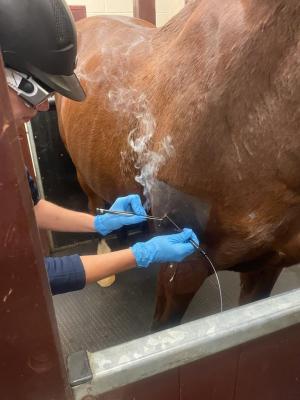Why Equine Therapy is Ending Up Being a Preferred Option for Emotional Wellness
Why Equine Therapy is Ending Up Being a Preferred Option for Emotional Wellness
Blog Article
Laser Therapy in Horse Therapy: A Modern Strategy to Improving Steed Health And Wellness
Laser treatment has become a critical technique in equine treatment, making use of concentrated light power to cultivate cellular fixing and expedite recovery from a variety of disorders. This non-invasive approach is particularly reliable in managing musculoskeletal injuries, wounds, and inflammatory conditions, dramatically improving general horse health. By stimulating mitochondrial task and improving ATP manufacturing, laser treatment not just boosts blood circulation but also offers significant pain alleviation. As this innovative treatment remains to gain grip, it opens up intriguing possibilities for dealing with chronic conditions like joint inflammation and hoof issues, signifying a transformative change in vet care. What makes this technique particularly compelling?
Understanding Laser Treatment
Laser treatment, a non-invasive treatment technique, has actually gotten significant traction in equine medicine due to its effectiveness in promoting healing and pain relief. This sophisticated therapeutic technique utilizes concentrated light energy to permeate cells, cultivating mobile fixing and regrowth. The underlying device entails the excitement of cellular mitochondria, bring about enhanced production of adenosine triphosphate (ATP), the energy currency of cells. Improved ATP levels quicken cells repair work procedures and reduce swelling, making laser therapy specifically reliable for dealing with musculoskeletal injuries, injuries, and other inflammatory conditions in horses.
There are numerous kinds of lasers made use of in equine treatment, each with particular wavelengths and power outcomes tailored to various healing requirements. Low-level laser treatment (LLLT), also referred to as chilly laser treatment, utilizes lower power levels to boost cell function without creating thermal damages. High-intensity laser therapy (HANDLE), in comparison, utilizes higher power levels to accomplish much deeper cells infiltration and even more significant healing results.
Veterinarians use numerous laser tools and strategies depending on the condition being treated and the preferred depth of tissue infiltration. Proper training and know-how are important for making sure the secure and reliable application of laser therapy, consequently maximizing its therapeutic capacity while minimizing risks.
Benefits for Equine Health
With a solid understanding of just how laser therapy functions, it is necessary to explore its numerous advantages for equine health and wellness. Among the main advantages is its capability to increase tissue fixing and cell growth. By stimulating mobile feature, laser treatment advertises faster injury healing and aids in the regeneration of damaged tissues. This can be particularly helpful in reducing recovery times for steeds suffering from injuries.
Moreover, laser treatment has been revealed to improve blood circulation, consequently enhancing blood circulation to influenced areas. Boosted blood circulation makes certain that essential nutrients and oxygen are supplied more efficiently, facilitating the recovery process. In addition, laser therapy's anti-inflammatory impacts help in lowering swelling and pain, which is crucial for the total well-being of the equine.
Discomfort management is one more significant advantage. By launching endorphins and obstructing discomfort signals, laser treatment gives reliable, non-invasive alleviation from both acute and chronic pain. This can add to improved flexibility and lifestyle for the pet.
Last but not least, laser therapy is a non-invasive therapy alternative, lessening the risk of difficulties related to even more intrusive procedures. Its adaptability and efficacy make it an invaluable tool in contemporary equine veterinary medication.
Common Problems Dealt With

An additional common condition treated with laser treatment is arthritis. Horses suffering from both acute and persistent arthritis take advantage of the anti-inflammatory effects of laser treatment, which aids to minimize discomfort and improve joint function. Additionally, YOURURL.com laser therapy is used in the monitoring of injuries. Whether managing surgical cuts or terrible injuries, the method promotes quicker cells repair work and lowers the risk of infection.
Equine respiratory problems, such as reoccurring airway blockage (RAO), additionally react favorably to laser treatment. Laser treatment is valuable in dealing with unguis problems, consisting of laminitis and abscesses.
Procedure and Security
Implementing laser therapy in equine therapy entails a meticulous treatment to guarantee both efficacy and security. Equine Therapy. The process begins with a comprehensive veterinary evaluation to establish the viability of laser treatment for the equine's details problem. Once considered appropriate, the treatment area is prepared by cleaning and, if needed, clipping the hair to boost laser infiltration
The expert must choose the appropriate kind of laser, usually a low-level laser (LLLT) or a high-power laser (HPL), depending upon the problem being dealt with. The laser device is after that calibrated to the proper wavelength, power, and duration index settings. Throughout the application, the expert relocates the laser over the targeted location in a methodical fashion, ensuring regular and also exposure.
Security methods are purely abided by, including making use of protective eyeglasses for both the professional and the equine. Furthermore, it is important to monitor the steed for any kind of indications of discomfort or damaging responses throughout the treatment. Post-treatment, the horse is frequently offered a duration of rest to permit the healing results to materialize.

Future of Horse Laser Therapy
As innovations in vet medication continue to unravel, the future of equine laser treatment holds substantial promise. Emerging innovations and much deeper scientific insights are established to improve and increase the applications of laser therapy for equines.
In addition, ongoing study right into the molecular and mobile devices of laser treatment will likely generate enhanced protocols customized to details conditions, boosting performance and minimizing treatment times. Customized treatment strategies based upon genetic and biochemical markers might come true, making certain that each steed gets one of the most proper and reliable care.
In addition, regulative innovations and standardization of protocols will enhance the trustworthiness and dependability of laser treatment in equine technique. Equine Therapy. As these advancements remain to arise, equine laser treatment is positioned to become a crucial component of veterinary treatment, offering improved healing and boosted lifestyle for equines around the world
Conclusion

Report this page